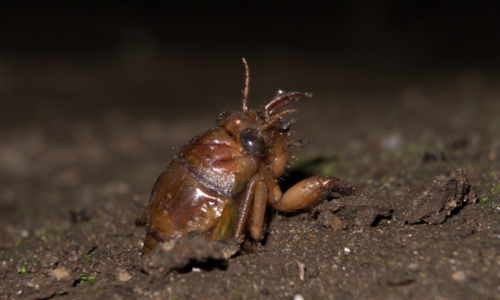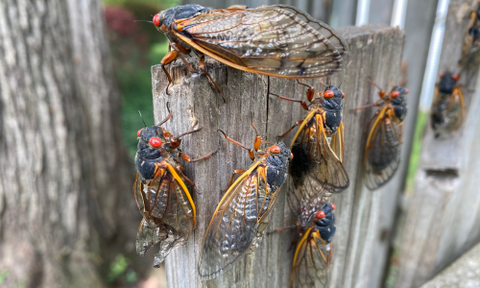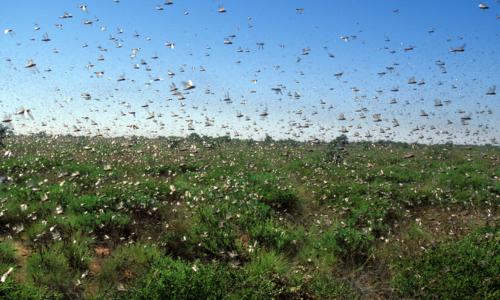Cicadas are a familiar sound of summer, with their distinctive chorus heralding the heat of the season. Yet, much of their life cycle—particularly the stages spent as cicada larvae underground—is shrouded in mystery.
With 2024 heralding the extraordinary and rare synchrony of Broods XIII and XIX's emergence in the United States—an event unfolding only once every 221 years—it presents an unparalleled opportunity to explore the enigmatic world of cicada larvae.
This exploration into the underground existence of these fascinating insects reveals a world as intriguing as the one we witness above ground.
Unveiling the underground: Cicada larvae explained
The term "cicada larvae" refers to the early, underground stage of a cicada's life cycle, before they mature into the buzzing adults familiar to us all. Immediately after hatching from eggs laid in tree bark, these larvae—technically known as nymphs—begin a journey that propels them deep into the earth. Here, they live a secretive existence, drawing sustenance from the xylem sap of plant roots. This sap, although nutrient-poor for most organisms, provides the essential nourishment cicada larvae need to grow and eventually transition to their adult form.

Unlike their adult counterparts, cicada larvae are devoid of wings and bear a more rounded, compact appearance. Their bodies are equipped with strong front legs adapted for digging, allowing them to navigate the underground environment. This hidden phase of their life is critical and forms the bulk of their lifespan, lasting anywhere from 2 to 17 years, depending on the species. During this time, cicada larvae undergo several molts, shedding their exoskeletons as they grow.
Fact: Some species burrow as deep as eight feet underground, though most cicadas stay within the top two feet of soil.
Fact: During their underground phase, a single female cicada can lay up to 600 eggs, divided among multiple sites to increase offspring survival rates.
The life beneath: Cicada larvae's 4 key underground roles
-
Cicada larvae engineer the earth: Cicada larvae create natural soil vents. Their tunneling activities carve out numerous passageways, which, thanks to a unique 'glue-like' substance they secrete, remain open throughout the growing season. This transformative process markedly aerates the soil, enhancing its structure and significantly improving water infiltration and root penetration. This 'glue' acts as a natural stabilizer for these subterranean channels, preventing collapse and ensuring a steady flow of air and nutrients.

- Cicada larvae irrigate the land: The emergence holes the cicadas leave behind act as conduits for rainwater, significantly enhancing soil moisture levels by allowing water to penetrate deeply beyond the surface layer. This influx of moisture promotes robust plant growth and stimulates microbial activity — essential components for sustaining a vibrant and healthy soil ecosystem.
- Cicada carcasses enrich the soil: Cicada larvae contribute to soil health through decomposing adult cicada carcasses, which significantly enriches the soil with nitrogen. This vital process turns cicada remains into a potent fertilizer, enhancing soil fertility and promoting a thriving ecosystem of plants and soil microbes.
- Cicada larvae influence atmospheric conditions: Cicada larvae's tunneling encourages microbial processes that increase carbon dioxide and nitrous oxide levels but may reduce methane—a subtle yet significant impact on greenhouse gas dynamics. Through this, cicada larvae contribute to the balance of gasses that shape our climate.
Embracing the marvel of cicada larvae and nature’s timeless cycle

As we stand on the cusp of witnessing the 2024 synchronized emergence of cicada Broods XIII and XIX, it's not merely an opportunity to revel in the sonic landscape they create but also to reflect on the profound underground journey that cicada larvae undertake.
This unique natural event, a once-in-multiple-lifetimes occurrence, opens a window into understanding the intricate web of life beneath our feet and the essential role cicadas play in our ecosystem.
Cicadas remind us that nature operates on a timeline far beyond our immediate perception, where the lengthy underground sojourn of cicada larvae mirrors the patient and deliberate unfolding of natural processes.
A call to action: Protect and participate
As champions of eco-friendly pest management, Dr. Killigan’s sees the cicada emergence not as a nuisance but as a natural marvel deserving respect and protection. To that end, we encourage you, our readers, to join us in embracing this event with curiosity and wonder.
Moreover, let this be a moment to consider the impact of our daily choices on the environment. Supporting sustainable practices, whether in pest management, gardening or daily living, ensures that we preserve the delicate balance of our ecosystems for future generations to witness their own cicada emergences.
Together, let's witness nature’s symphony

As 2024 approaches, prepare to welcome the cicadas with open minds and hearts. Let their song be a reminder of the incredible journey they’ve undertaken and the hidden wonders that unfold in the depths of the earth. Engage with the natural world, educate yourself and others about the value of cicadas and their larvae, and take action towards a more sustainable and ecologically mindful way of living.
Join Dr. Killigan's in anticipating this extraordinary event. Together, we can celebrate the secret lives of cicada larvae and the myriad ways they enrich our planet. Dive deeper into the marvels of the natural world and discover how, even in the smallest creatures, lies the heart of the earth’s most profound mysteries.
Your role in a greener tomorrow starts today
The upcoming cicada emergence is a perfect metaphor for the potential of transformation—both in the natural world and in our environmental stewardship. Let’s take this unique opportunity to learn, grow,and contribute to a healthier, more sustainable planet. Explore Dr. Killigan's range of eco-friendly products and join us in our commitment to responsible pest management and environmental preservation. Together, we can ensure that the buzz of cicadas continues to herald the summers of the future, in a world where nature and humanity thrive in harmony.










